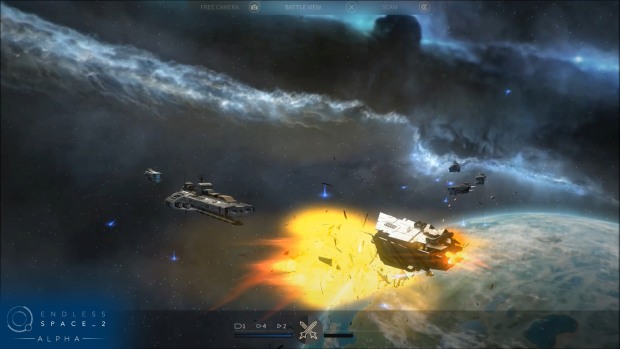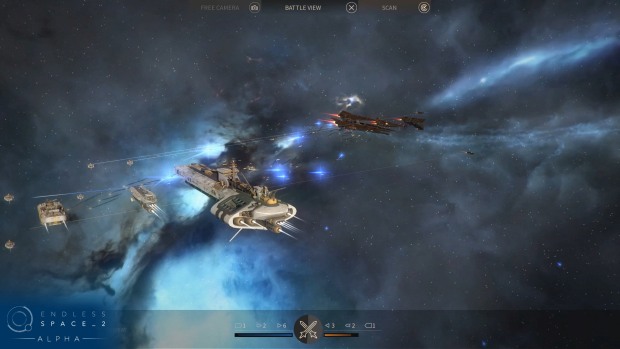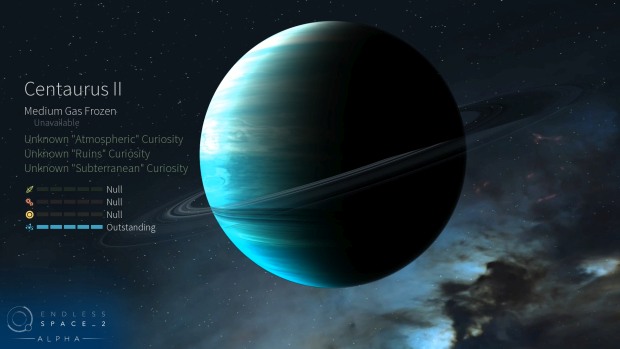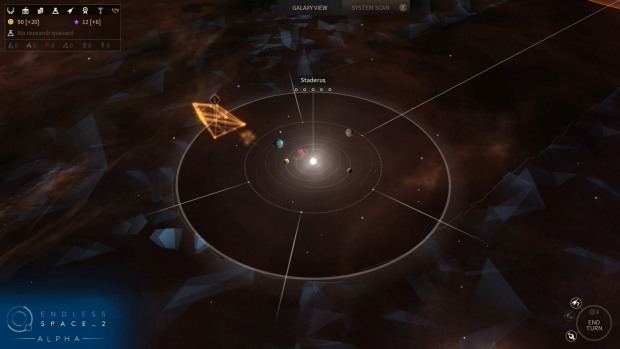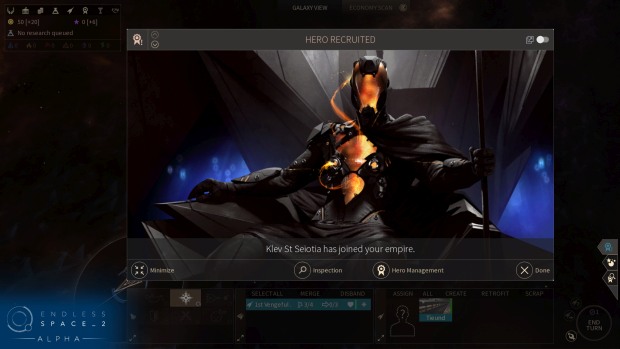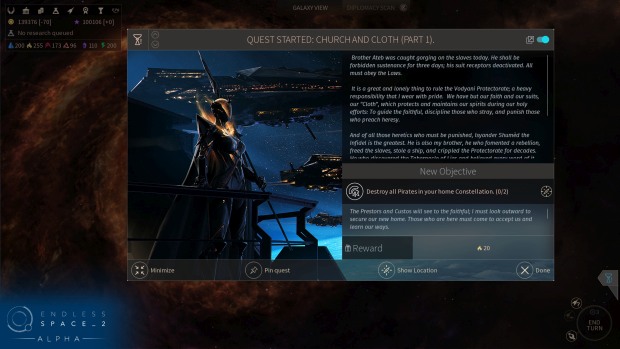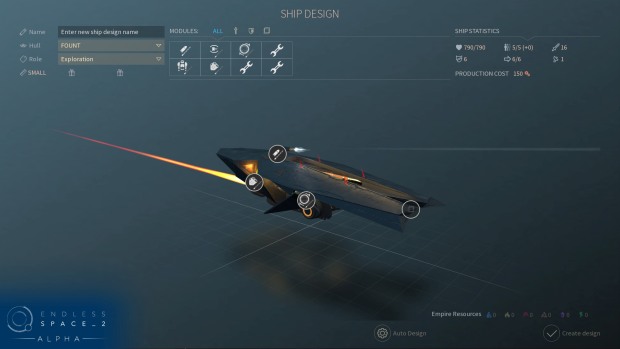Interview: Endless Space 2's Devs On Why They Traded Independence For Sega
"We needed more money"
Amplitude Studios has grown significantly since the Parisian developer, as a small team that you could count on one hand, first conceived Endless Space. Now they work out of two floors in a high-rise near the centre of the metropolis and are busy working on their fourth game, Endless Space 2. Recently, they announced a partnership with publisher Sega.
It’s an evolution and escalation that’s echoed in their games. Endless Space 2, then, is an opportunity to show everyone just how much they’ve grown, combining the ideas that birthed their first game with the lessons they’ve learned through the much lauded Endless Legend. I spoke to the company's two founders to discuss why they're making the game now, what the partnership with Sega means for the studio, and more.
“Endless Space 2 is, in many ways… we don’t have a proper word for it, but in many ways it’s a reboot,” explains co-founder and creative director Romain de Waubert de Genlis.
He seems a little hesitant to use the word ‘reboot’ because it isn’t starting from scratch. A lot of the original game can be seen in this sequel, but at the same time it’s not a direct continuation. It’s connected, both to Endless Space and Endless Legend, but as fellow founder Mathieu Girard clarifies, it’s a bigger perspective on the universe and its origins.
The studio didn’t start work on this sequel right away, after the launch of Endless Space and then its DLC, because they didn’t want to burn out. They wanted to be stimulated by new things, fresh perspectives, and also have time to consider the feedback from their first game. Endless Legend gave them that new perspective, and its impact on Endless Space 2 is dramatic.
“It showed us how we could do better,” de Genlis admits. “When working on Endless Legend, there were all these cool things we added that would have been so cool in Endless Space.” One of those things was the refreshing prominence of the fantasy 4X game’s narrative, which Amplitude wove throughout multiple levels of the game.
“Endless Legend has proven that it’s possible to add a strong narrative layer to an otherwise very systemic game,” says Girard. “4X games are, in essence, systemic games where you put game mechanics together and then have an experience emerge, but then we proved it was possible to have a great story arc for each faction and lots of cool stuff that made it unique compared to other 4Xs.”
Along with their unique hooks, like the vampiric Vodyani’s ability to kidnap people from other worlds or the Lumeris’ use of private companies to buy entire planets, each faction in Endless Space 2 has its own narrative arc, with epic quests accompanying it. You can read more about those factions elsewhere. This isn’t a zero-sum situation, either, notes de Genlis. “It doesn’t replace, just enhances, giving players more tools to feed their imagination.” Nothing has to be taken away for a story to thrive.
So while the narrative and universe-building is now part of Amplitude's DNA, mechanics and meaningful choices that go beyond each faction’s story beats remain just as important. Some of that is also inspired by features from Endless Legend, like the tech tree that offers a multitude of choices but splits them up into different eras, but there’s plenty that’s new as well, like the focus on the population and politics of a faction.
People – whether they are space parasites, tree monsters or amphibious deal-brokers – are what make a faction, and they are defined by a set of traits. The Lumeris, for example, are pacifists, caring more about affluence and family than war. This determines what makes them happy, and what a leader must do to maintain the support of their people. Populations aren’t static things, however. They can transform as immigrants appear from other worlds, bringing with them their own traits, and then they can transform through the choices their ruler makes.
“The political system is in some ways perpendicular to the faction system, because even though a faction can be scientific or militaristic, they can still evolve depending on your choices,” Girard tells me. “So there is more depth for the players to make different factions based on the choices on the political side.”
While some of these factions are new, returning players will also notice the return of some classic races. “It’s a good mix, to have classic factions, to revisit them with the new gameplay mechanics, and then to bring in new stuff, especially the community faction,” says Girard.
The aforementioned community faction was created as part of a competition. You can take a gander at them here, before they find their way into the game. Even among the unique factions that Amplitude have designed, they stand out. “It was something missing from the universe,” de Genlis notes, hence their inclusion.
“They must have unique gameplay, or take advantage of one or two special parts of the game,” Girard says of the faction design process. “So some will be especially adapted to diplomacy, or war, or the economy. To make sure we have different gameplay styles for the player, we make sure that we have factions that cover different parts of the game and which allow for different playstyles within the factions. And then we build on that with the story.”
Art, gameplay and story all feed into each other, beginning with looking for an archetype that makes room for a specific playstyle. “And then we sit down with the artists, present this to the them, and what we tend to do is work with a group of artists – four, five, six artists – all of them try to give it a shot, showing how they see these factions,” de Genlis explains. “What’s interesting is by seeing them draw, so it could be just the way they look, but it could be their lifestyles, most of the time that will feed back to both the storyline and gameplay, and then we start working with this circle between these three types of jobs – between game design, writing and art – until we have something we love.”
It’s not rigid and set in stone. In Endless Legend, the lore was still being worked on until the last weeks of development, de Genlis tells me, laughing.
Population and politics aren’t the only new mechanics that Endless Space 2 explores. Amplitude have reconsidered combat, which has shifted from the card-based battles of its predecessor, and is very different from the tactical scraps of Endless Legend. There’s a planning phase, where players can see the potential strategies of their opponents, while selecting one of their own from a list determined by their fleet and technology they’ve researched. After that, a titanic space clash is shown off with a level of grandeur and cinematic detail that’s rare in the genre.
“We’re working with a national movie director [Bertrand Le Cabec], and our engineers have made the tools for him to select the angles and direction, motion etc,” Girard explains. “Then the game is going to generate events – this ship has joined the battle, this ship is firing its weapon, this ship is damaged or destroyed – and the [AI] director is going to filter all these events and pick the one that makes the most sense, avoiding repetition, avoiding stuff that’s too short or not interesting. Every time the director is trying to find the best angle and most interesting stuff to show.”
Then there’s the ground combat, where players need to make a choice about how to deal with or manage an invasion, and all the while troops duke it out on the ground, as preemptive bombing strikes batter the world and leaders attempt to evacuate or defend the planet with everything they’ve got. Again, the impact this has on a population is an important factor, reminding players of the stakes: there are civilians at risk and they aren’t just numbers.
In July, Amplitude made one of its biggest changes: a partnership with Sega, joining fellow strategy developers like Creative Assembly and Relic Entertainment. It’s an arrangement that’s been in the making for over a year, while Amplitude was in discussions with other companies.
“They weren’t the first ones to approach us; they were probably the last ones,” de Genlis says. “We never imagined big companies would look at us seriously. They asked us if we wanted to work with them, if we wanted to join them, and we were just like ‘No, no. We’ll meet you, thank you, that’s cool, that’s nice.’ It’s flattering, and after a while we started really thinking about it.”
“It really made us think about what we wanted to do as a company,” Girard adds. “We want to make games that we like, with big partners like Sega providing all the boring stuff, which we don’t want to do, whether it is IT, or business, or localisation work. They are, as they present themselves now, a service company, while the studios like Amplitude, and of course Creative Assembly and Relic, are leading the creation. It’s all the benefits without the inconvenience.”
Making their decision easier was the fact that both of them were already big fans of Sega’s other studios. “We love their games. Romain is more into Creative Assembly’s games; I’m more into Relic’s. And there’s lots of our guys who love these studios and their products as well. And I think there are fans of our games at Creative Assembly and Relic too. There’s a lot of affinity. But it doesn’t mean Sega is going to force us to work together. If we think some cooperation is interesting and preferable for both studios, then we can do it. If we want to work on maybe the AI together, and exchange, it’s possible, but it’s not mandatory. It’s great because it’s based on our needs.”
The timing was perfect. Just over a year ago, Girard and de Genlis were realising that their projects needed to be bigger and more ambitious so they could compete with all the new 4X titles coming out, and that made development more expensive. “We’re not alone anymore, and we needed to adapt, we needed more money, more marketing, more presence, and that’s not our job. That’s why the timing was good, with these companies coming to see us, to see if we could work together.“
An assumption is sometimes made that, when a developer partners with a publisher, especially a large one like Sega, they won’t be able to take risks anymore, or that their creativity is threatened. Not according to de Genlis. “Independence means you are free to take the risks that you want. The thing is, when you’re alone and you take these risks, sometimes you can just die if you don’t do it properly. Which is okay, it’s your own choice, but it means that after a while you decide to not take risks anymore, and then you stop being creative, and then you die.”
The partnership with Sega, then, means that Amplitude can concentrate on the things they love the most, while Sega handles the more mundane stuff. The mundane stuff doesn’t include dealing with the community, however, as that’s something Amplitude continue to be extremely passionate about.
“When we recruit someone for the team, we make sure they can interact with the community,” de Genlis says. “It’s a requirement. Not just to make jokes, but to talk about the game and expand and share. This whole process of exchanging with the community is part of their job. And of course we build upon that to do everything we can to reduce the distance between our players and ourselves.
“It’s important to hear our players tell us what they love and what they hate about elements of our game. We want to make sure we have these exchanges before we ship the game, not after. After it’s not too late, but there are so many things that you could have done differently if you knew, and that’s why we try to make sure that whatever we do, we do under the spotlight of our players.”
That spotlight will soon be brighter than ever, as Endless Space 2 heads toward Early Access this month.


